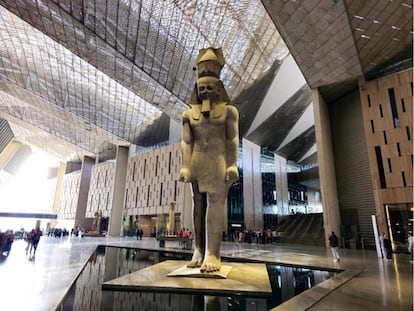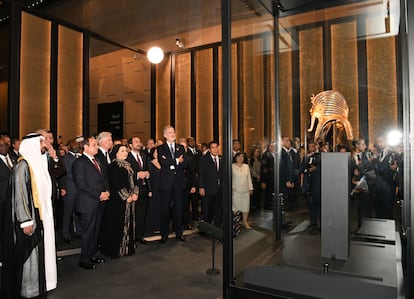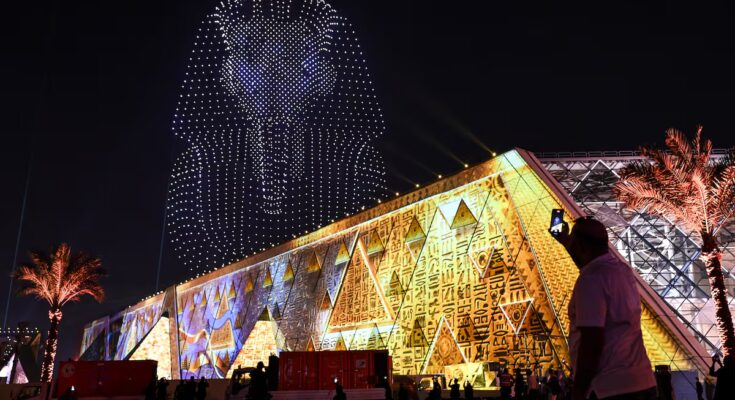The GEM, the Great Egyptian Museum, has finally been inaugurated, the new flagship of the monumental and tourist offer of the Nile Country, acclaimed as “the fourth pyramid” and the largest center in the world dedicated to a single civilization of antiquity. The truth is that, after much delay (the first stone was laid 23 years ago), many of us did not believe that the GEM had truly been inaugurated until they saw the images of President Abdel Fattah al Sisi greeting dignitaries as they unloaded their cars in a long line of high-end cars next to the new museum, amidst trumpets and fanfares. Once we got there, it would be very cool to do another sit-in.
The opening ceremony, which I followed online, era typically Egyptian, with a great display of resources, especially human – there is no shortage of people: hundreds of extras dressed as ancient Egyptians and with a cane lamp finished in the shape of a pyramid that will cause a sensation at Ikea – and the overloaded sumptuousness to which the country’s authorities have accustomed us on big occasions. As if they reopened the Suez Canal or the New Library of Alexandria, with which the GEM, in Arabic al-Mathaf al Misriyy al-Kabir, which stands a stone’s throw (2 kilometers) from the pyramids of Giza, has some resemblance.
The gala was long and colorful and brought to mind that scholar’s warning: “It is the duty of Egyptology to awaken the dead, not send the living to sleep.” I remember from the ceremony the drones that drew Egyptological icons in the sky (like Tutankhamun’s mask or his coffin), the fireworks, the dervishes and the lasers that dotted the pyramids; the two majestic orchestras performing a highly eclectic program (Debussy, Rimsky-Kórsakov, traditional Nubian music), or the singers, well-known faces of the star system Egyptian – which followed one another between panoramic aerial views of the museum and travel for its interiors, especially the grand staircase of statues and the grand atrium (everything is big at the GEM). I really liked the part in which it was represented, bathing in blue light the entire patio of the GEM, the submerged Alexandria, the old city under water, many of whose remains, saved by Frank Goddio’s dive team, are displayed in its rooms. The presence of creatures such as nereids or mermaids floating in space added a dreamlike and fairy-like dimension.
But above all, with the permission of Rania of Jordan and her red dress, I am left with the exciting appearance of pharaonic kings and queens both outside the new center, which occupies the area of 70 football pitches, and in other monumental points to which the festival was connected (the Sphinx, the Inclined Pyramid, the temple of Abu Simbel, that of Deir el Bahari, that of Luxor or that of Philae). I seemed to recognize Ramses II, Tutankhamun (chubby and with a thick golden scarab on his chest), Akhenaten, Hatshepsut, Nefertiti, Nefertari, Cleopatra… However, what surprised me most was to see among the members of one of the recreated royal courts, the one lined up in Giza, a princess just like Anck-Su-Namun!, fictitious concubine of Seti I and secret lover of the great priest Imhotep in The mummy, the 1999 version of the classic.
It is difficult to say whether the girl present at the ceremony, who carried with her a large ankh, the Egyptian Ansada cross of life, resembled by pure chance the actress Patricia Velasquez from the film, the villain of the story, or whether someone decided to wink at the most recalcitrant Egyptomaniacs. But the fact is that the appearance of the princess with long raven hair, a haughty, angular and sensual face and a golden dress (less daring than the one in the opening scene of the film, mind you) caused a shock and brought you to the ceremony in a way that the official speeches did not.

If you think that the strangest hallucination was that suddenly the screens took us to Japan to see a group of extras dressed as Egyptians dancing in Kyoto. Or that we would then move to Sydney, New York (near the Statue of Liberty) and Rio de Janeiro (Christ the Redeemer on Corcovado, which, try as we might, didn’t look like a Colossus of Memnon) to find other musicians and dancers. Japan’s problem is obviously explained by the fact that the country has invested a lot of money in the construction of the museum (800 million). Paris was also there (Eiffel Tower and accordions), perhaps as a nice allusion to France’s return to Egypt of the alleged Zodiac of Dendera – whose looting Champollion himself criticized – which fortunately the Louvre thieves did not take, which would have been difficult to explain to the Egyptians.
Also surprising were the constant allusions to peace, not because it is not a good wish in these difficult times but because if Ancient Egypt was not something, it is a peaceful civilization. Indeed, Ramesses II would have been shocked (and the phrase is worth it) to hear how the Battle of Kadesh was mentioned in the ceremony – in the midst of which the pharaoh had himself depicted on the walls of his temples mercilessly crushing his enemies with his chariots – to celebrate the peace treaty with the Hittites, “the first of its kind in history”. Some ultralights also flew over the pyramids with banners proclaiming “Welcome to the land of peace” and alluding to the concept of Maat, justice and balance, while Al Sisi solemnly declared that the only way to build civilizations is peace.
It was emphasized that the grand spectacle was not just to celebrate the inauguration of the GEM – which is expected to attract 5 million visitors a year, increasing tourism by 20% – but to celebrate Egypt’s entire civilization, promote its cultural riches (including Copts and Muslims) and send a message to the world not only about the hope and desire for peace, but about the country’s economic strength. Significant, in this regard, were the images of the new administrative capital under construction and its Iconic Tower of almost 400 meters, rival of the GEM obelisk, the only suspended one in the world. It was also telling that together with the projections of the great monuments, the great hotels of Egypt were shown, such as the Palace of Gezirah or the Ancient Cataract in Aswan.
Among the old acquaintances who were present at the inauguration, the former Ministers of Culture Faruk Hosni (under whom the new museum was conceived) and Khaled El Anany (now the new director of UNESCO) and the inevitable Zahi Hawass, who took the opportunity to underline that the heart of the GEM is the treasure of Tutankhamun, the almost 6,000 objects found in his tomb and which have now been transferred from the ancient Egyptian Museum of Tahrir Square, are on display in their entirety for the first time, including the two sad fetuses, the unborn children of Tut and Ankhesenamun (on whose name Anck-su-Namun is based, among other things), placed in the tomb. For a few days (the entire museum opened to the public on Tuesday and the turnout was extraordinary) visitors have been able to see the two rooms of Tut (7,000 square metres), but the opening ceremony allowed us to see some images of how the collection was set up: in an environment full of sadness and mystery, and references to the KV62 tomb, with the protagonist pieces (mask, sarcophagi, chariots, the king’s mannequin, the canopic chapel, the sentinel, the figure of the pharaoh on a panther) clearly highlighted in the large room.

There were numerous references to Tutankhamun in the ceremony. It was less predictable that Howard Carter would be there as it happened, although the inauguration opted for legend and to give credit for the discovery of the tomb to the Egyptian boy Hussein Abd el-Rassul, who supposedly found the first step leading to the tomb. Pictures of the little water carrier and the famous pictures of Carter working on the tomb were shown. And finally another child, also in the flesh, Asher, became the protagonist of the ceremony, discovering with childish amazement all the wonders of the museum, which are many: 100,000 objects from the Predynastic to the Roman period, including the two solar boats of Cheops.
Some of us find it difficult to accept the move from the old, romantic Tahrir Square museum of 1902, where we experienced so many things, to the new, sparkling, ultra-modern and vast GEM. But if we put ourselves in the Egyptian perspective, that museum of neoclassical craftsmanship (which remains open, although much stripped of the best objects) was still an expression of a colonial past. It is enough to recall the numerous references to the European heroes of Egyptology or the tomb of Auguste Mariette itself in the garden (or the celebration on the pediment, in Latin, of Khedive Abbas II, puppet of the English). With the new museum, which places such great value on the treasure of Tutankhamun, the discovery of which marked the paradigm shift in Egyptology and the full assumption that the antiquities of Egypt are the indisputable heritage of the country, we are entering a new era in which Egyptians can look at their great pharaonic museum as something completely theirs and feel very proud.



